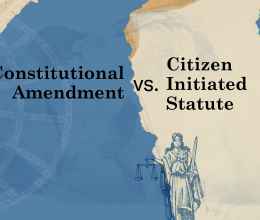It’s been over five years since the city of Cleveland entered into a settlement agreement with the U.S. Department of Justice (DOJ), mandating that Cleveland make specific, compressive reforms to its police department. The agreement, or consent decree, was initially projected to last five years. Yet, here we are at the end of 2020, and there is still much work to be done.
How We Got Here
It’s no secret that the Cleveland Division of Police (CDP) has a long history of problematic and harmful practices. The existing consent decree can be traced to an earlier DOJ investigation in 2002, where the DOJ reviewed the CDP for issues related to conditions of confinement, excessive force, and racial profiling. The DOJ and Cleveland entered into a voluntary agreement as a result. The DOJ then terminated that agreement in 2004.
The current consent decree is based on the findings of a 2013-14 DOJ investigation that found CDP officers engaged in a pattern and practice of excessive force in violation of the Fourth Amendment. It was agreed upon by the DOJ and city of Cleveland in May 2015 and requires the CDP to make a number of fundamental changes to its policies, procedures, and practices. The document outlines a plan for resolving issues surrounding use of force, biased policing, officer training, and accountability for police misconduct, among others. A federal judge oversees and enforces the consent decree to ensure that the city and CDP complies with the changes delineated in the document. The court is assisted by an independent Monitor and Monitoring Team that assesses and reports whether the requirements of the consent decree have been implemented. Another vital body – but not a party to the agreement – is the Cleveland Community Police Commission (CPC), which was established by the consent decree. The group is tasked with soliciting feedback on police policies from the Cleveland community and works to empower the community’s voice in the reform process.
The consent decree terminates when CDP has been in "substantial and effective" compliance with all provisions of the agreement for two consecutive years. The timeline for the reform process has shifted over time, with the initial 2020 completion date viewed out of reach in 2018. Cleveland is now aiming for consent decree reforms to be completed in 2022. However, only time will tell whether or not the CDP will be able to demonstrate full compliance by then.
Where are we with the Consent Decree?
As part of the consent decree, the Monitor and city of Cleveland are required to file public reports on the status of reform efforts. Over time these reports, along with other court filings, have demonstrated the achievement of milestones and identified outstanding areas of work. The Monitoring Team released its most recent (eighth) semiannual report in July, which covers September 2019 – February 2020. The city followed with its response in the filing of its ninth status report in September.
At this stage, the CDP has revised, and the court has approved, most of its major policies across reform areas as required by the consent decree. This includes use of force, supervisory investigations, community engagement, bias-free policing, crisis intervention, search and seizure, recruiting, and discipline policies. CDP officers and supervisors have received initial training on a number of these new and revised policies as required. With the foundational pieces of the consent decree requirements – policies, procedures, and trainings – complete, some feel that the city is at a turning point. Looking at the bigger picture, next steps appear to focus on data collection and testing new accountability measures.
According to the Monitoring Team’s report, use of force incidents remained down in 2019, as well as the number of officer and civilian injuries, which can be linked to inappropriate force. Additionally, the Office of Professional Standards (OPS) – the civilian-staffed office charged with investigating the complaints of civilians about CDP personnel – has eradicated a sizable and long-standing backlog of civilian complaints filed against police officers from prior to December 2018. There have been improvements in the quality of the OPS investigative process, though work still remains with regards to community awareness and the timeliness of handling both community and internal complaints.
The Monitoring Team reported that the CDP still lacks the technology and data needed for officers to be able to provide the basic information required to successfully assess performance in key areas (stops, searches, and arrests; interactions with individuals in behavioral crisis; and community policing and problem-solving). In addition, they raised other concerns that will require ongoing attention moving forward, specifically related to the city and CPD’s strained relationship with the CPC and resources and processes for investigating officer misconduct. The city responded in their recent status report stating that these concerns had been resolved or are in the process of being addressed, noting that they did not agree with the Monitoring Team’s categorization of their relationship with the CPC. Continued collaboration between the parties will determine whether or not the measures put in place are sufficient.
So yes, technically progress has been made with the consent decree, but there is a long way to go. Arguably the road ahead is tougher than the road just traveled. As a country, we are in the midst of a social justice reckoning, with communities nationwide calling to divest in police. That conflicts with what we are currently seeing in Cleveland. Implementing the consent decree reportedly costs Cleveland between $6 and $11 million annually. The extension of the consent decree means that Cleveland will most likely need to put more towards policing efforts to pay for a monitoring team and implement reform efforts.
In Cleveland, there continues to be a lack of accountability and transparency when it comes to the police, and that’s with a federal consent decree in place. The Monitor bringing to light in July years of Cleveland’s former safety director, Michael McGrath, failing to take adequate disciplinary against officers who committed misconduct is just one example. Then there is the CDP’s handling of protests in response to the tragic murder of George Floyd early this summer, where a peaceful demonstration ended with protestors getting tear gassed and dodging rubber bullets. The city released its After-Action Review Report on the May 30th demonstration earlier in December, and the Monitoring Team will be focusing their upcoming (ninth) semiannual report on the CDP’s preparedness, response, and after action activities related to the various planned and unplanned protests from late May through mid-June. However, images and firsthand reports from protestors tell a different side of the story – that Cleveland continues to fail to protect those that they serve.
Policies and procedures, while critical, are nothing more than empty words on paper if they are not implemented and there is no accountability. So while the CDP has put in place a series of new policies, procedures, and processes and conducted the training, the true test will be in what comes. What will happen when an officer does not comply with the new standards? Will officers be held accountable for misconduct, or will the status quo continue? Additionally, the city and the police department don’t seem to recognize that the crux of the consent decree hinges on its relationship with community. This was acknowledged by the Monitor when he noted that the city and the CDP’s relationship with the CPC was extremely fractured in the Eighth Semiannual report, stating that “Nothing in the city and division’s relationship with the Commission suggests an interest in or the importance of the community substantively participating on areas of police reform and police practice.”
Reform efforts are wasted time, energy, and money if there isn’t a culture change. Rebuilding community trust and policing with respect to individual rights are necessary steps in that process. Can it be achieved in Cleveland? As the city enters into its sixth year of federal oversight, that remains to be seen.
Additional Resources:








